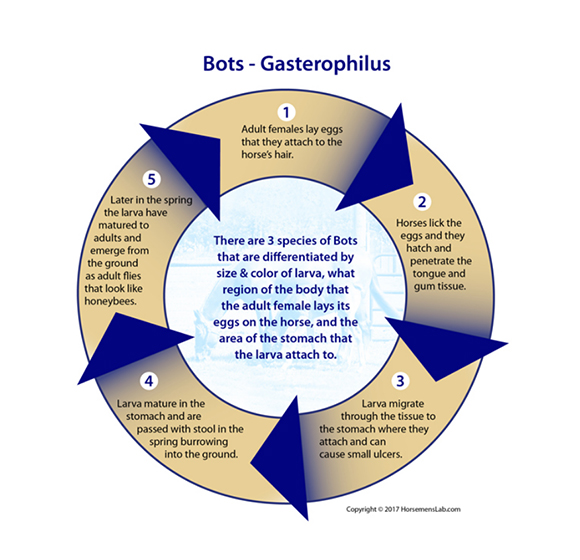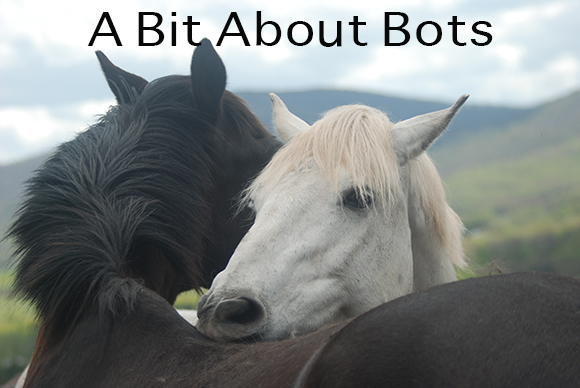A Bit About Bots
Bot eggs may appear as small yellow, white or grey specks on your horse’s coat. These are eggs and commonly attached themselves to your horse’s front legs, neck (mane and withers) or under his jaw. The eggs are laid on your horse’s coat by female flies that look a bit like honeybees, and the eggs will hatch into larvae when contacted by the saliva from a horse’s lips.
Other signs that your horse is infected with bots are excessive salivation, chewing issues and irritation of the mouth. A high population of bot larvae may even cause pus in the oral cavity. Not pleasant!
While horses can easily reach the deposited eggs on their front legs and consequently lick and ingest the eggs, given that most horses are not able to reach their own manes and wither area, grooming by another horse will enable transmission of eggs deposited at these locations to their respective lips and mouth.
As the eggs hatch into larvae they will burrow into the horse’s tongue, around teeth in gingival pockets and after 21 to 28 days will then molt and be swallowed by the horse and migrate to the stomach. Here they continue to develop while attached to the mucosal lining of the stomach and just past the stomach in the alimentary canal.
Amazingly aside from the mouth irritation the horse does not appear to experience discomfort or other issues from the ulceration that the larvae produce in the alimentary canal or stomach. A large population of bots hosted by the horse may cause many small ulcers that have the potential to become one large ulcer, which could produce a colic risk, but this is unusual.
The larvae spend the winter inside the horse, to be excreted back onto the pasture during the warmer Spring months.
Interestingly, the female bot fly dies due to lack of energy after she has laid her eggs on the horse's coat. It used to be thought that the cold weather killed the female bot fly, but recent studies have shown this is not the case.

We spoke with equine parasitology expert Dr. John Byrd, who has run more than 75,000 equine fecal worm egg count tests (F.E.C.T’s) Horsemen’s Laboratory, to find out how we can detect bot populations in the horse and how best we should treat for the presence of bots.
“The presence of bot larvae in a horse fecal egg count test is seldom seen. Obviously any bot larvae found in a sample would indicate the horse is infected with bots. Unlike testing for stronglyes worms, there is no simple test you can do for bots. For this reason, it is a good idea to deworm your horse once a year to mitigate bot populations. The ideal time to deworm the horse to break the life cycle of bot species is late Autumn, early Winter. A dose of Ivermectin or Moxidectin should do the trick,” advises Dr. Byrd.
Meantime removal of the eggs visible on the horse’s coat will help defray the discomfort of these larvae stage bots reaching your horse’s mouth. There are many different methods for such removal. You can utilize a bot comb or bot knife, or carefully use a disposable razor. Lava stone grooming blocks act as a type of sandpaper and may successfully remove the eggs and the traditional method of wiping the eggs off with vinegar may work. Use gloves if you decide to pick them off by hand, you don’t want eggs underneath your fingernails! Bot eggs can be difficult to remove, so be patient.
If you apply mineral or baby oil to the horse’s coat after removing the visible eggs, more egg laying antics may be reduced.
About Horsemen’s Laboratory: Established in 1993 by John Byrd D.V.M., an experienced lifelong horseman and a graduate of the University of Illinois College of Veterinary Medicine. As an equine medicine practitioner in California for 13 years, Dr. Byrd served as ex-officio member of the board of directors of the Pacific Coast Quarter Horse Racing Association where he also served as the organization’s official sales veterinarian. In addition, Dr. Byrd frequently officiated, as veterinarian for horse shows sponsored by the management of Orange County Fairgrounds in Costa Mesa, California. Dr. Byrd’s extensive experience with horses led him to observe how a horse’s health could impact performance leading to the founding of the specialist lab for equine fecal worm egg counts.
Dr. Byrd enjoys sharing his wealth of knowledge of equine parasitology with horse owners from all walks of life., and is available to provide lectures/symposiums for your club, organization or event. Please contact Dr. Byrd via his website for rates and further information.



